Oklahoma State University–Stillwater
Oklahoma State University (OSU) is a public land-grant research university in Stillwater, Oklahoma. OSU was founded in 1890 under the Morrill Act. Originally known as Oklahoma Agricultural and Mechanical College (Oklahoma A&M), it is the flagship institution of the Oklahoma State University System. Official enrollment for the fall 2010 semester system-wide was 35,073, with 23,459[5] students enrolled at OSU-Stillwater. Enrollment shows the Freshman class of 2012 was the largest on record with 4,298 students.[5] OSU is classified by the Carnegie Foundation as a research university with highest research activity.[6]
 | |
| Type | Flagship Public Land-grant Space-grant |
|---|---|
| Established | December 25, 1890 |
| Affiliation | Oklahoma Agricultural & Mechanical Colleges |
Academic affiliation |
|
| Endowment | $756.5 million (2019)[1] |
| President | V. Burns Hargis |
Administrative staff | 1,857 |
| Students | 25,295[2] |
| Location | , , United States 36°07′56″N 97°04′51″W |
| Campus | Small city, 1,489 acres (6.03 km2) on the Stillwater campus[3] |
| Colors | Orange and Black[4] |
| Nickname | Cowboys and Cowgirls |
Sporting affiliations | NCAA Division I – Big 12 |
| Mascot | Pistol Pete |
| Website | go |
 | |
The Oklahoma State Cowboys and Cowgirls' athletic heritage includes 52 national championships, a total greater than all but three NCAA Division I schools in the United States, and first in the Big 12 Conference.[7] Students spend part of the fall semester preparing for OSU's Homecoming celebration, begun in 1913, which draws more than 40,000 alumni and over 70,000 participants each year to campus and is billed by the university as "America's Greatest Homecoming Celebration."[8]
History

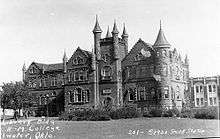
On December 25, 1890, the Oklahoma Territorial Legislature finally gained approval for Oklahoma Territorial Agricultural and Mechanical (A&M) College, the land-grant university established under the Morrill Act of 1862. It specified that the college was to be within Payne County. Such an ambiguous description created rivalry between towns within the county, with Stillwater ultimately winning out. Upon statehood in 1907, "Territorial" was dropped from its title.
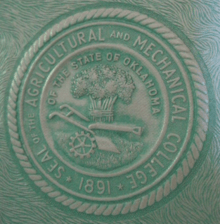
The first students assembled for class on December 14, 1891. Classes were held for two and one-half years in local churches until the first academic building, later known as Old Central, was dedicated on June 15, 1894, on the southeast corner of campus, which at the time was flat plowed prairie.[9] In 1896, Oklahoma A&M held its first commencement with six male graduates. The first Library was established in Old Central in one room shared with the English Department. The first campus building to have electricity, Williams Hall, was constructed in 1900. With its turreted architecture it was referred to as the "Castle of the Prairies";[10] It remained standing until 1969. One of the earliest campus buildings was also a barn, used as part of an agricultural experiment station, which was served by a large reservoir pond created in 1895. The barn burned in 1922, but the pond, enlarged and remodeled in 1928 and 1943, is now known as Theta Pond, a popular campus scenic landmark.[11] In 1906, Morrill Hall was completed and became the principal building on campus. A fire gutted the building in 1914, but the outside structure survived intact, and the interior was reconstructed.

On-campus housing at Oklahoma A&M College began in 1910, with the opening of the Boy's Dormitory.[12] Later renamed Crutchfield Hall, the Historic American Buildings Survey said it was significant as "... the first permanent boy's dormitory in Oklahoma ... [and] the sole surviving example of a pre-1930 utilitarian dormitory that is characteristic of modified Italian Renaissance Revival architecture".[13] Crutchfield Hall later served the School of Music and the College of Engineering, Architecture, and Technology before its demolition in 1955.[12] Also opened in 1910 was the Women's Building, containing a dining hall, home economics classes, and a women's gymnasium, in addition to resident housing for female students. It was later named Garner Hall and survives to the present day as the Bartlett Center for the Studio Arts and houses the Gardiner Art Gallery.[12][14] By 1919 the campus included Morrill Hall, the Central Building, the Engineering Building (now Gundersen Hall), the Women's building, the Auditorium (replaced later by the Seretean Center for Performing Arts),[15] the Armory-Gymnasium (now the Architecture Building) and the Power Plant.[16]
At the beginning of World War II, Oklahoma A&M was one of six schools selected by the United States Navy to give the Primary School in the Electronics Training Program (ETP), also known as Naval Training School Elementary Electricity and Radio Materiel (NTS EE&RM).[17] Starting in March 1942, each month a new group of 100 Navy students arrived for three months of 14-hour days in concentrated electrical engineering study. Cordell Hall, the newest dormitory, was used for housing and meals; lectures and lab sessions were held in the Engineering Building. Professor Emory B. Phillips was the Director of Instruction. ETP admission required passing the Eddy Test, one of the most selective qualifying exams given during the war years.[18] At a given time, some 500 Navy students were on the campus, a significant fraction of the war-years enrollment. The training activity continued until June 1945, and served a total of about 7,000 students; among these was Robert B. Kamm, a future professor and president of Oklahoma State University.[19][20] During some of the war years, the Navy also had a Yeoman training activity for WAVES and SPARS on the campus.
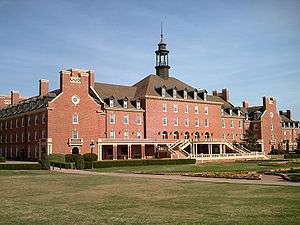
Much of the growth of Oklahoma A&M and the campus architectural integrity can be attributed to work of Henry G. Bennett, who served as the school's president from 1928 to 1950. Early in his tenure Dr. Bennett developed a strategic vision for the physical expansion of the university campus. The plan was adopted in 1937 and his vision was followed for more than fifty years, making the university what it is today, including the Georgian architecture that permeates the campus. The focal point of his vision was a centrally located library building, which became a reality when the Edmon Low Library opened in 1953. Another major addition to the campus during the Bennett years was the construction of the Student Union, which opened in 1950. Subsequent additions and renovations have made the building one of the largest student union buildings in the world at 611,000 sq ft (56,800 m2).[21] A complete renovation and further expansion of the building began in 2010.
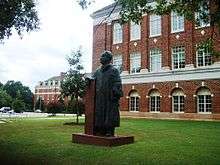
On May 15, 1957, Oklahoma A&M changed its name to the Oklahoma State University of Agricultural and Applied Sciences to reflect the broadening scope of curriculum offered. Oklahoma Gov. Raymond Gary signed the bill authorizing the name change passed by the 26th Oklahoma Legislature on May 15, 1957. However, the bill only authorized the Board of Regents to change the name of the college, a measure they voted on at their meeting on June 6. However, the name was quickly shortened to Oklahoma State University for most purposes, and the "Agricultural & Applied Sciences" name was formally dropped in 1980. Subsequently, the Oklahoma State University System was created, with the Stillwater campus as the flagship institution and several outlying branches: OSU-Institute of Technology in Okmulgee (1946), OSU-Oklahoma City (1961), OSU-Tulsa (1984), and the Center for Health Sciences also in Tulsa (1988).[22]
In 2005, OSU announced its "Campus Master Plan", a campaign to enhance academic, athletic, and administrative facilities. Over $800 million is ear-marked for campus construction and renovation over twenty years. The Plan calls for an "athletic village" where all of the university's athletic facilities will be located on the main campus. To accomplish this goal, the athletic department bought all (or nearly all) the property north of Boone Pickens Stadium up to McElroy between Knoblock and Washington streets. This drew criticism from the city of Stillwater and property owners.[23] While the vast majority of the real estate was rental property targeting college students, a few owners were longtime residents. There was a lone holdout in this parcel of land, who sued OSU over their right to use eminent domain.[24] The case was decided in favor of the University. The project includes the construction of an indoor practice facility for most sports, a soccer stadium/outdoor track, a tennis complex, and a baseball stadium.
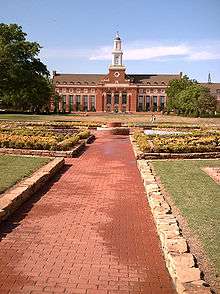
In 2006, OSU became the recipient of a gift of $165 million from alumnus T. Boone Pickens to the university's athletic department, and in 2008 received another gift from Pickens of $100 million for endowed academic chairs. It was the largest gift for academics ever given in the state.[25] Ethical concerns have been raised in media reports about the propriety of how some of the Pickens gifts have been made, immediately returned to Pickens, and then placed in hedge funds owned by Pickens' companies[26] In February 2010, Pickens announced that he was pledging another $100 million to fund a scholarship endowment as part of a $1 billion fund-raising campaign titled "Branding Success." The pledge brought the total pledged or contributed to OSU by Pickens to over $500 million.[27]
On October 24, 2015 during the annual homecoming parade, Adacia Chambers drove her vehicle into a crowd of people killing 4 people and injuring 47.[28]
Colleges
Oklahoma State University–Stillwater offers nearly 200 undergraduate degree majors through six Colleges:
- Ferguson College of Agriculture (Previously the College of Agricultural Sciences and Natural Resources)
- College of Arts and Sciences
- College of Education, Health, and Aviation
- College of Engineering, Architecture, and Technology
- College of Human Sciences
- Spears School of Business
OSU provides further opportunities for select students to study, conduct research, and exchange ideas in a more challenging and supportive academic environment through the Honors College.
The graduate degree programs of all colleges are administered through the Graduate College.
The Center for Veterinary Health Sciences (CVHS) has three academic Departments: Veterinary Pathobiology, Physiological Sciences, and Veterinary Clinical Sciences. Each of the three academic departments share responsibility for the four-year professional curriculum leading to the Doctor of Veterinary Medicine (D.V.M.) degree. The interdepartmental Veterinary Biomedical Sciences graduate program offers MS and PhD degrees. It also offers ECFVG and PAVE programmes for foreign trained veterinarians.
Rankings and reputation
| University rankings | |
|---|---|
| National | |
| ARWU[29] | 138–155 |
| Forbes[30] | 358 |
| Times/WSJ[31] | 373 |
| U.S. News & World Report[32] | 192 |
| Washington Monthly[33] | 153 |
| Global | |
| ARWU[34] | 501–600 |
| QS[35] | 751–800 |
| Times[36] | 401–500 |
| U.S. News & World Report[37] | 493 |
As a land-grant university, OSU has several historically renowned programs, including the College of Agricultural Sciences and Natural Resources and the College of Veterinary Medicine. The College of Engineering is renowned in the fields of architecture and mechanical engineering. The School of Entrepreneurship is internationally renowned at both the practical and academic levels.
- It has been named a Truman Honor Institution for its success in producing Truman scholars.[38]
- OSU is one of five U.S. universities where Sun Grant Research Initiative programs have been established by the U.S. Congress in the Sun Grant Research Initiative Act of 2003 for the purposes of researching and developing sustainable and environmentally-friendly bio-based energy alternatives.
- The Math Department has been recognized by the American Mathematics Association as one of four innovative programs in the nation and has produced four Sloan Fellowship winners.[39]
- The Oklahoma Mesonet, a state-of-the-art network of environmental monitoring stations that is an OU-OSU partnership, won a special award from the American Meteorological Society (AMS), the nation's leading professional society for those in the atmospheric and related sciences at the National Weather Center.[40]
- OSU is headquarters for the International Ground Source Heat Pump Association,[41] which has members from as far away as Sweden, Japan, Australia, England and South Africa.
- OSU is home to Fire Protection Publications and the International Fire Service Training Association, the largest publisher of fire and emergency services books in North America.
- OSU's Homecoming was awarded the Council for Advancement and Support of Education (CASE) Seal of Excellence. Presented each year by the Oklahoma State University Alumni Association, "America's Greatest Homecoming Celebration" began in 1913 and today draws more than 70,000 alumni and fans back to Stillwater for events like the Harvest Carnival, Walkaround and Sea of Orange Parade. It is widely regarded as one of the best homecoming celebrations in the U.S.[8]
- Each year the School of Entrepreneurship hosts the "Experiential Classroom", an intensive 3-day seminar for entrepreneurship educators. It has been widely recognized as being the top program of its kind. In 2011, the program hosted entrepreneurship faculty from 29 states, 17 countries, and 65 different universities.[42]
Student life
Housing
Current university-owned housing options include 31 residence halls, more than 15 dining options, and six family-first apartment complexes. In recent years, on-campus housing has been undergoing significant transformation. Student living was previously dominated by traditional residence halls; however, apartment-style buildings now comprise approximately half of the living quarters.[43] In 2005, the high-rise Willham North and South residence halls that once dominated the Stillwater skyline were demolished and replaced with the Village suites on its site.[44] Iba Hall, another traditional hall, was closed in 2007, but was reopened in 2011 due to an increase of incoming freshman.[45] In 2017, Iba Hall underwent significant renovations which lasted through most of that year, before reopening in time for the Fall 2018 semester.
Iba, Parker, Wentz and Stout Halls continue to offer traditional residence hall accommodations. In addition, three residence halls were opened in the fall of 2015, collectively known as the University Commons. North houses female students, south houses male students, and west is a co-ed facility that also houses the twenty-four-hour service desk for the area. Although Kerr-Drummond was slated to be closed with the opening of the University Commons, Drummond was reopened in fall 2015 due to increased occupancy of campus housing.[46] Kerr was closed and is scheduled for demolition in the coming years. Apartments for single students are Bost, Davis, Morsani-Smith, Peterson-Friend, Kamm, Sitlington and Young Halls. Housing in suite-style accommodations are provided in the named Village CASNR (College of Agricultural Science and Natural Resources), Village HS (Human Sciences), Village C, Village D, Village E and Village F. Deluxe suites are provided in Patchin & Jones, Bennett, Zink & Allen, and Stinchcomb & Booker Halls.[47] Graduate students and families are offered accommodations in seven apartment "neighborhoods" with a variety of floor plans and amenities: Brumley, Demaree, Prosser, Stevens, West, and Williams.[43]
Additionally, a number of learning communities and special interest housing options are available, providing opportunity for students who share interests or majors to live together. Most of these communities occupy certain floors of buildings or halls, rather than consisting of separate buildings. Included among the options are: FIT (Freshman in Transition, College of Agricultural Sciences and Natural Resources), athletic training, career exploration (College of Arts and Sciences), computer science floor, engineering floors, health and sciences floor, HS housing (College of Human and Environmental Sciences), journalism and broadcasting housing, Kamm Leadership House, Ketchum House (Native American interests), James Building (Young Engineers House), Maude's Quad (Women in Engineering House), Recovery House (students recovering from drug and/or alcohol dependence), Spanish House (language immersion), Spears School of Business House, Stout Honors housing (University's Honors Program), Uhuru House (African Centered Cultural House), Wellness House, and The Transfer Zone (transfer students).
Fraternity & Sorority life
Oklahoma State University's fraternities and sororities celebrated 100 years of existence at OSU in 2008.
Social fraternities and sororities at Oklahoma State are divided among four councils: Panhellenic, Interfraternity, National Pan-Hellenic and Multicultural.
Thirteen national Panhellenic sororities have chapters at OSU. They are: Alpha Chi Omega, Alpha Delta Pi, Alpha Omicron Pi, Alpha Xi Delta, Chi Omega, Delta Delta Delta, Gamma Phi Beta, Kappa Alpha Theta, Kappa Delta, Kappa Kappa Gamma, Phi Mu, Pi Beta Phi, and Zeta Tau Alpha.
Twenty-one fraternities make up the Interfraternity Council. Member fraternities include: Alpha Gamma Rho, Alpha Sigma Phi, Alpha Tau Omega, Beta Theta Pi, Beta Upsilon Chi, Delta Tau Delta, FarmHouse, Kappa Alpha Order, Kappa Sigma, Lambda Chi Alpha, Phi Delta Theta, Phi Gamma Delta, Phi Kappa Sigma, Phi Kappa Tau, Pi Kappa Alpha, Sigma Alpha Epsilon, Sigma Chi, Sigma Nu, Sigma Phi Epsilon, Sigma Tau Gamma, and Theta Chi.
NPHC member organizations are historically black fraternities and sororities. As of the 2018-2019 school year, Alpha Phi Alpha, Delta Sigma Theta, Omega Psi Phi, Phi Beta Sigma, and Zeta Phi Beta have chapters at OSU.
The Multicultural Greek Council is the umbrella organization for additional minority Greek letter groups. Member organizations include Alpha Pi Omega, Kappa Delta Chi, Sigma Lambda Alpha, Sigma Lambda Beta, Omega Delta Phi.
Student organizations
Organizations are available to students through the university that serve any interest. A complete list of campus organizations can be found on OSU's website.[48]
Athletics

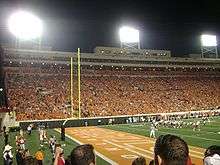
Stats:
- NCAA Division I-A
- Conference: Big 12
- Major Rivalries: University of Oklahoma Sooners
- Minor Rivalries: University of Texas Longhorns, University of Kansas Jayhawks, Iowa State University Cyclones (wrestling)
- NCAA Championships: 52 (#4 after Stanford, USC, and UCLA)
- Wrestling: 34
- Golf: 11
- Basketball: 2 (1945 and 1946)
- Baseball: 1 (1959)
- Cross Country: 4 (1954, 2009, 2010, 2012)
- National Championships not sanctioned by NCAA: 5
- Equestrian: 4
- Football: 1 (1945)
- Athletic Director: Mike Holder
Football
10 conference titles – 26 bowl games played – 1988 Heisman Trophy winner and single season rushing record (Barry Sanders).
Basketball
Men's basketball is tradition rich at Oklahoma State. Oklahoma State made the Final Four in 1995 and 2004 and was the first ever Division 1 basketball program to win back-to-back National Championships in 1945-1946.
Wrestling
The Cowboy wrestling team brought home their 33rd NCAA championship in spring 2005, scoring the most points ever by an Oklahoma State wrestling team in the NCAA. OSU won their 34th overall (and 4th consecutive) title in 2006.[49] OSU's 34 team titles are the most ever collected by a school in one sport. The Cowboys have also produced 127 individual national champions, including the sport's first-ever four-time champion, Pat Smith.
Other sports
Since the 1924 Olympics, 68 Oklahoma State University Olympians have won a total of 30 medals: 21 gold, four silver, and five bronze.[50]
Fight songs
Notable among a number of songs commonly played and sung at various events such as commencement, convocation, and athletic games are: The Waving Song, Ride 'Em Cowboys (the Oklahoma State University fight song), and the OSU Chant.[51] At the end of every sporting event, win or lose, OSU student-athletes face the student section and sing the alma mater along with other students, faculty, alumni and staff.
People
Today, there are more than 200,000 living OSU alumni worldwide.[52] Prominent alumni include oil tycoon and billionaire philanthropist T. Boone Pickens, actor James Marsden, "the father of the personal computer" Ed Roberts, country singers Garth Brooks and Hoyt Axton, former Prime Minister of South Korea Nam Duck-woo, former Prime Minister of Jordan Adnan Badran, US Senator Tom Coburn, former Governor of Oklahoma Mary Fallin, former acting Surgeon General of the United States Robert A. Whitney, Oklahoma Supreme Court Justice Steven W. Taylor, David Noel Ramírez Padilla rector of Tecnológico de Monterrey Mexico's most prestigious university, former Central Bank of Somalia Governor Yussur A.F. Abrar, production designer and drummer K.K. Barrett, legal scholar Anita Hill, and Ponnala Lakshmaiah, an Indian politician.
Interviews with OSU Alumni can be viewed and heard through the O-State Stories Project of the Oklahoma Oral History Research Program.[53]
Faculty
A number of prominent scholars, authors and researchers have served on the OSU faculty, including poet Ai, historian Angie Debo, literary critic and author Brian Evenson, mathematician William Jaco, computer scientist and philosopher Subhash Kak, chemical engineering scholar Nicholas A. Kotov, information studies pioneer and research librarian Edmon Low, engineering pioneer J. Tinsley Oden, and highly cited psychologist Robert Sternberg (who now teaches at Cornell University).
In recent decades, number of notable academic administrators have served on the Oklahoma State faculty, including Guy Bailey (who would serve as President of the University of Alabama), Ray M. Bowen (who served as President of Texas A&M), Hilton Briggs (who served as President of South Dakota State University), Robert W. MacVicar (who went on to become President of Oregon State University), James E. Martin (who served as President at Auburn and the University of Arkansas), J. Tinsley Oden (who served as Provost for the University of Texas at Austin), Robert Sternberg (who left to become President of the University of Wyoming), and Paul Torgersen (who served as President of Virginia Tech).
Athletics
Coaching alumni include OSU wrestling head coach John Smith, OSU football head coach Mike Gundy, and former OSU basketball coaches Eddie Sutton and Sean Sutton. The Cowboys have produced several NBA players, including Desmond Mason, formerly of the Oklahoma City Thunder, Marcus Smart of the Boston Celtics, Jawun Evans of the Los Angeles Clippers, Tony Allen of the New Orleans Pelicans, James Anderson of the Sacramento Kings, Joey Graham of the Cleveland Cavaliers, Stephen Graham of the New Jersey Nets, JamesOn Curry of the Chicago Bulls, Terrel Harris of the Miami Heat, and former New York Knicks guard John Starks. NFL players Barry Sanders and Thurman Thomas also attended OSU, as did baseball All-Star pitcher Joe Horlen and All-Star third baseman Robin Ventura. Ventura went on to manage the Chicago White Sox for five seasons. Also in the NFL are former Cowboys Dez Bryant and Dan Bailey of the Dallas Cowboys, and Kevin Williams of the Minnesota Vikings. Retired MMA and UFC Hall of Famers Randy Couture and Don Frye, and former UFC welterweight champion Johny Hendricks wrestled at OSU. Former UFC light heavyweight champion Daniel Cormier wrestled at the university, as well as other MMA fighters including Mark Muñoz. PGA professional golfers Rickie Fowler, Scott Verplank, Bo Van Pelt, Charles Howell III, Bob Tway, and Hunter Mahan also attended OSU. Two-time gold medalist, ESPN analyst, and ASA Hall of Fame inductee Michele Mary Smith played softball at OSU. Houston Nutt and Brent Guy, both former players and teammates, became head coaches after serving as assistants for the Cowboy football program.
Campus buildings
- Listed below are just a few of the buildings at OSU. For a complete list, visit List of Oklahoma State University buildings.
Academic buildings
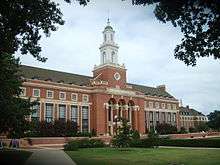
- 4-H Youth Development
- Advanced Technology Research Center
- Agriculture
- Agriculture North
- Animal Sciences
- Bartlett Center for the Visual Arts
- Biosystems and Agriculture Engineering Lab
- Classroom Building
- Colvin Center
- Donald W. Reynolds School of Architecture
- Edmon Low Library
- Endeavor Lab
- Engineering North
- Engineering South
- General Academic Building (former Spears School of Business)
- Gundersen
- Henry Bellmon Research Center
- Human Sciences
- Human Sciences West
- Life Sciences East
- Life Sciences West
- Mathematical Sciences
- McElroy Hall
- Morrill Hall
- Murray Hall[54]
- Noble Research Center
- North Classroom
- North Murray
- Old Central
- Paul Miller Journalism and Broadcasting Center
- Physical Sciences
- Robert M. Kerr Food & Agricultural Products
- Seretean Center for the Performing Arts
- Spears School of Business
- Whitehurst Hall
- Willard Hall
- Wes Watkins Center for International Trade Development
Residential buildings
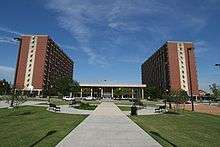
- Allen Hall
- Cordell Hall (now closed)
- Davis Hall
- Drummond Hall (now closed)
- Kerr Hall (now closed)
- Morsani-Smith
- Parker Hall
- Wentz Hall
- Patchin Hall
- Jones Hall
- Booker Hall
- Stinchcomb Hall
- Iba Hall
- Bennett Hall
- Stout Hall
- University Commons
- University Village Suites
- Willham North Hall (now closed)
- Willham South Hall (now closed)
Other buildings
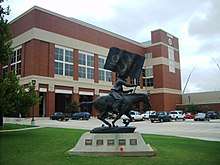
- Allie P. Reynolds Stadium – Baseball
- Bennett Memorial Chapel
- Boone Pickens Stadium – Football stadium named after T. Boone Pickens
- Cowgirl Stadium
- Historic Gallagher-Iba Arena – Named top collegiate venue in the United States by CBS Sportsline. It is named after Edward C. Gallagher and Henry Iba. It is home to practice facilities, weight and locker rooms as well as the original white maple wood basketball court. The court is named Eddie Sutton Court, in honor of the former OSU Men's Basketball Coach. Sutton led the Cowboys to two Final Four appearances during his time as coach.
- National Wrestling Hall of Fame and Museum
- Student Union – Known as the largest student union in the world.[55] Portions of the 1992 film All-American Murder were filmed at the Student Union.[56]
- Whitehurst Hall administration building
See also
- Gift of a Lifetime
- Johnny Bright Incident – An incident that occurred during a football game on Saturday, October 20, 1951
- List of forestry universities and colleges
References
- As of June 30, 2019. "U.S. and Canadian 2019 NTSE Participating Institutions Listed by Fiscal Year 2019 Endowment Market Value, and Percentage Change in Market Value from FY18 to FY19 (Revised)". National Association of College and University Business Officers and TIAA. Retrieved April 22, 2020.
- "Oklahoma State University - Main Campus". Carnegie Classification of Institutions of Higher Education. 2017. Retrieved February 6, 2019.
- "History and Background Information – Budget & Asset Management – Oklahoma State University". Vpaf.okstate.edu. Archived from the original on July 20, 2011. Retrieved February 24, 2011.
- "Oklahoma State University's Official Colors". July 1, 2019. Retrieved July 25, 2019.
- "2014 Endowment Market Value" (PDF). nacubo.org. June 30, 2014. Archived from the original (PDF) on February 23, 2017. Retrieved March 18, 2015.
- "Carnegie Foundation – Oklahoma State University – Main Campus". Carnegiefoundation.org. 2010. Retrieved September 5, 2011.
- "NCAA Summary, National Collegiate/Division I Men's" (PDF). Archived from the original (PDF) on June 27, 2010. Retrieved February 24, 2011.
- "OSU Alumni Association – Homecoming History". Orangeconnection.org. October 30, 1920. Retrieved February 24, 2011.
- "Campus Beginnings: 1890–1940 – SCUA Online Exhibit – OSU Library". Library.okstate.edu. January 29, 2007. Archived from the original on January 1, 2011. Retrieved February 24, 2011.
- "OSU Library History". Library.okstate.edu. Archived from the original on March 24, 2011. Retrieved February 24, 2011.
- "Special Collections: Theta Pond". Library.okstate.edu. September 22, 2008. Archived from the original on January 2, 2011. Retrieved February 24, 2011.
- "OSU Housing and Residential Life celebrates centennial". Oklahoma State Housing and Residential Life. October 18, 2010. Retrieved November 17, 2019.
- "Oklahoma State University, Boys Dormitory, Northwest corner of Hester Street & Athletic Avenue, Stillwater, Payne County, OK". Historic American Buildings Survey. Retrieved November 17, 2019.
- "Facilities // Oklahoma State University Department of Art". Art.okstate.edu. Archived from the original on May 4, 2015. Retrieved October 26, 2015.
- Archived June 4, 2010, at the Wayback Machine
- [A History of the Oklahoma State University Campus, by J. Lewie Sanderson, R. Dean McGlamery, and David C. Peters]
- Test and Research Staff, Bureau of Naval Personnel; “Psychological test construction and research in the Bureau of Naval Personnel. Part V. Navy radio technician training program”; American Psychologist, vol 1(3), Mar. 1946, pp 80-90
- Naeter, Albrecht; "Naval Training School," The Oklahoma State Engineer, Dec. 1943
- Watson, Raymond C., Jr.; Solving the Naval Radar Crisis, Trafford Publishing, 2007, pp. 208-211, ISBN 978-1-4251-6173-6
- "OSU Student Union Building History". Union.okstate.edu. September 9, 1950. Archived from the original on July 20, 2011. Retrieved February 24, 2011.
- "OSU History" Archived September 1, 2006, at the Wayback Machine
- "Pickens's Donation to Oklahoma State Spurs Fight on Land Grab". Boone State. Archived from the original on October 8, 2007. Retrieved May 24, 2007.
- "Lone Holdout Blocks Pickens's Vast Sports Project at Oklahoma State U." The Chronicle of Higher Education. Retrieved May 24, 2007.
- Dallas Morning News, "T. Boone Pickens donates $100M to OSU" Archived September 7, 2008, at the Wayback Machine
- Gose, Ben (October 30, 2008). "Concerns are Raised about how Oklahoma State U Handled a Gift". Chronicle of Higher Education.
- "NewsOK, "With T. Boone Pickens' gift, OSU kicks off drive for $1B"". Newsok.com. February 27, 2010. Retrieved February 24, 2011.
- "Woman faces 2nd-degree murder charges in Oklahoma crash". Msn.com. Archived from the original on October 29, 2015. Retrieved October 26, 2015.
- "Academic Ranking of World Universities 2019: USA". Shanghai Ranking Consultancy. Retrieved August 16, 2019.
- "America's Top Colleges 2019". Forbes. Retrieved August 15, 2019.
- "U.S. College Rankings 2020". Wall Street Journal/Times Higher Education. Retrieved September 26, 2019.
- "Best Colleges 2020: National University Rankings". U.S. News & World Report. Retrieved September 8, 2019.
- "2019 National University Rankings". Washington Monthly. Retrieved August 20, 2019.
- "Academic Ranking of World Universities 2019". Shanghai Ranking Consultancy. 2019. Retrieved August 16, 2019.
- "QS World University Rankings® 2021". Quacquarelli Symonds Limited. 2020. Retrieved June 10, 2020.
- "World University Rankings 2020". THE Education Ltd. Retrieved September 14, 2019.
- "Best Global Universities Rankings: 2020". U.S. News & World Report LP. Retrieved October 22, 2019.
- OKCBusiness – Oklahoma City Business News Archived April 3, 2008, at the Wayback Machine
- https://sloan.org/past-fellows
- "Program Timeline". mesonet.org. Retrieved January 31, 2018.
- "What is IGSHPA?". Igshpa.okstate.edu. Archived from the original on April 4, 2009. Retrieved February 24, 2011.
- "Spears School hosts entrepreneurship faculty from 29 states, 17 countries and 65 universities - Spears School of Business News". Spears.okstate.edu. Retrieved October 13, 2014.
- https://reslife.okstate.edu/housing-options/neighborhoods/
- https://www.ocolly.com/suites-to-replace-willham-north-and-south/article_27d0ae48-28f1-555e-9f89-c0b562520044.html
- https://www.ocolly.com/iba-hall-closing-after-summer/article_8bc479b0-904a-519d-aeca-d036d007a504.html
- https://www.ocolly.com/news/residential-life-announces-closure-of-drummond-hall/article_46b487d2-2703-11e8-9a05-57e2f67ae30e.html
- https://reslife.okstate.edu/housing-options/halls/index.html
- "Oklahoma State Student Organization List". Archived from the original on May 4, 2018. Retrieved May 5, 2018.
- "Oklahoma State Wins Fourth Straight NCAA Wrestling Title". big12sports.com. Archived from the original on November 6, 2006. Retrieved March 29, 2007.
- "Olympians". okstate.com. Retrieved November 12, 2018.
- "Oklahoma State University Gameday Traditions". okstate.com.
- "OSU Alumni Association". Orangeconnection.org. Retrieved February 24, 2011.
- "O-State Stories Oral History Project, Oklahoma Oral History Research Program". Library.okstate.edu. December 8, 2010. Archived from the original on April 9, 2011. Retrieved February 24, 2011.
- "Oklahoma State to take segregationist's name off buildings".
- "About Us". Union.okstate.edu. August 20, 1950. Archived from the original on July 17, 2011. Retrieved February 24, 2011.
- "Filming Locations for All-American Murder (1992) (V)". Internet Movie Database. Retrieved January 28, 2007.
External links
| Wikimedia Commons has media related to Oklahoma State University. |
_logo.svg.png)